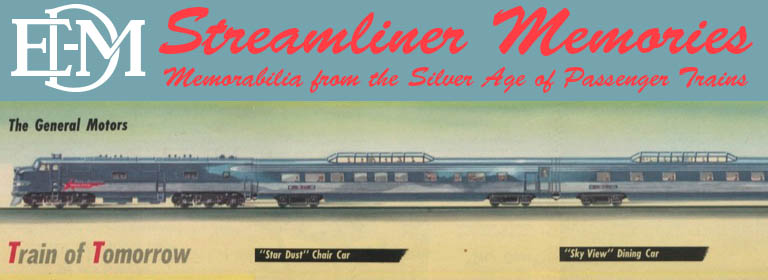The Union Pacific was so confident about the success of the M-10000 that it ordered three more similar, but longer, trains even before the M-10000 was completed. Though the power cars of these trains were outwardly identical to the M-10000, with “turrent-style” cabs, the M-10001 was initially equipped with a 900-HP Diesel instead of the M-10000’s 600-HP distillate engine.
After receiving the M-10001 in the fall of 1934, the Union Pacific sent it from Los Angeles to New York in under 57 hours, a record that stands today. The train’s average speed over this route, however, was just 57 mph, compared with the Zephyr’s 77-mph run from Denver to Chicago and later the Denver Zephyr’s 83-mph run from Chicago to Denver (which, Ralph Budd pointed out, was uphill).
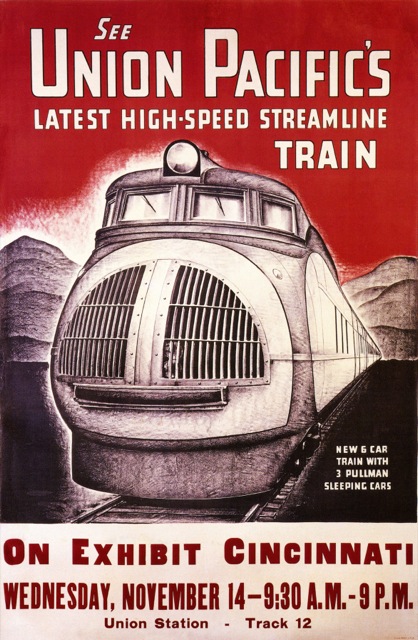
So before putting the M-10001 in revenue service, Union Pacific replaced its 900-HP engine with a massive, V-16, 1,200-HP Diesel. It then put the train to work as the City of Portland, running between Chicago and Omaha on the Chicago & North Western and from Omaha to Portland on the Union Pacific, taking 39-3/4 hours each way. Considering that previous trains took between 54 and 72 hours, this was an incredible schedule. A Chicagoan going to Seattle would have to change trains in Portland and would still arrive in Seattle nearly 20 hours sooner than if they took the Empire Builder, North Coast Limited, or Olympian.
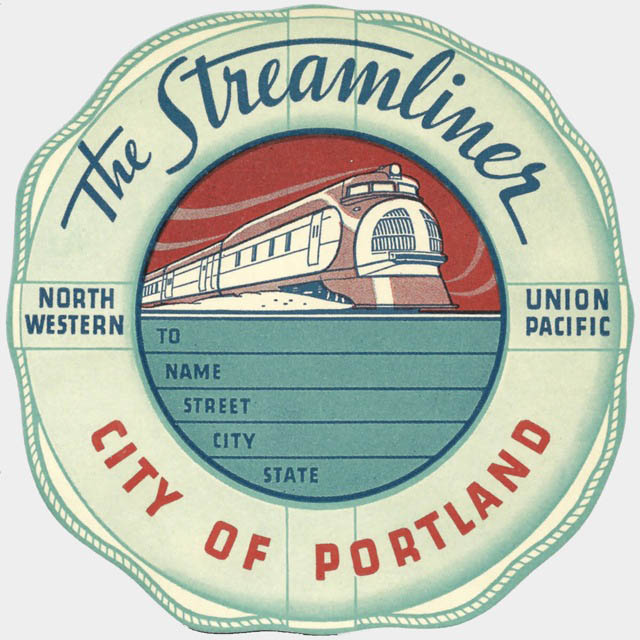
For some reason, the Union Pacific adopted a maritime metaphor for its streamliners, even referring to departures as “sailings.” This luggage sticker carries the metaphor by using a life preserver to symbolize the train.
However, the Union Pacific only had one train, and four were required to provide daily service. To make matters worse, though the train could make at least seven round trips a month, the Union Pacific scheduled it just five times a month. For example, in the summer of 1936 the train left Portland on the 1st, 7th, 13th, 19th, and 25th of each month and left Chicago on the 4th, 10th, 16th, 22nd and 28th. That seems like a lot of unnecessary down time for a train that was no doubt booked full almost every run.
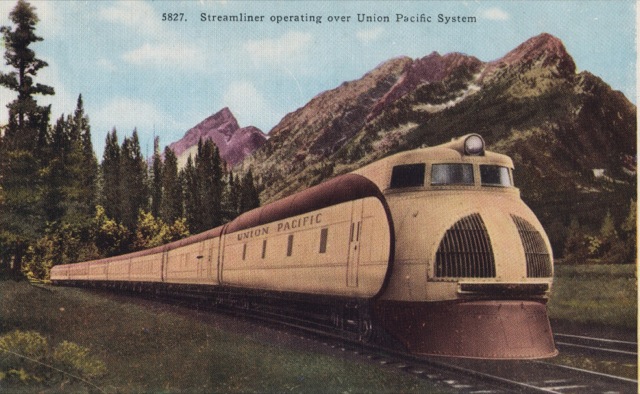
The back of this postcard calls this the City of Los Angeles, but judging from the length of the train it is probably really the M-10001, City of Portland. The mountain in the background isn’t an obvious landmark on either route, and I suspect both the train and tracks were superimposed on another photo. Click to download a PDF showing both the front and back of this postcard.
Union Pacific’s next streamliner, the M-10002, wasn’t completed until early 1936. It had three more cars than the M-10001, making a total of nine plus two power cars: one with a 1,200-HP V-16 similar to the M-10001 and the other with the 900-HP Diesel that the Union Pacific had removed from the original M-10001. The lead locomotive retained the same “turret” design as the M-10000 and M-10001.
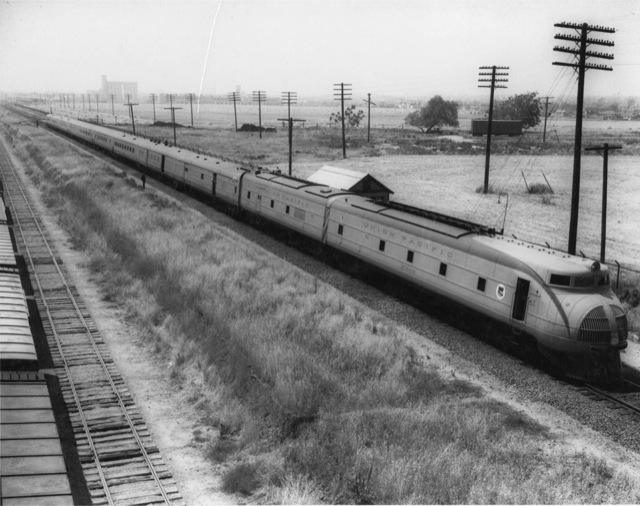
Considering all the publicity given to the M-10000 and M-10001, there are remarkably few photos of the M-10002. Here is one during its brief service as the City of Los Angeles.
Instead of pairing the M-10002 with the City of Portland to provide every-other-day service, Union Pacific elected to run it from Chicago to Los Angeles. Like the City of Portland, the City of Los Angeles made its journey in 39-3/4 hours, allowing travelers to use just one business day to make their trip. Like the City of Portland, it was scheduled to operate just five times a month.
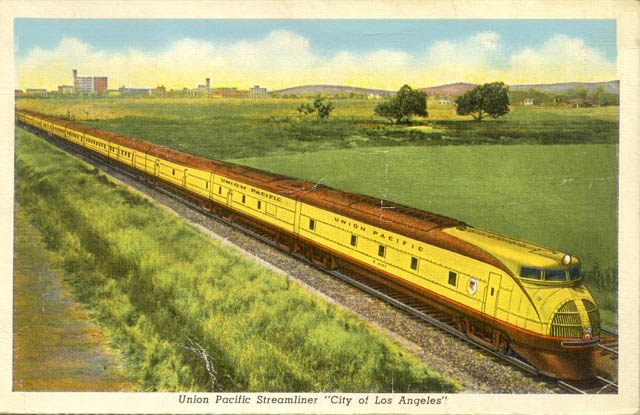
This postcard is obviously based on the above photo.
The Union Pacific quickly discovered that it had underestimated demand for these streamliners, so it cancelled its order for the M-10003 and instead placed orders for an entirely new set of streamliners featuring more powerful, redesigned locomotives and more cars than ever. The first of these were used for the City of Denver and City of San Francisco, but by the end of 1937 the railroad had enough new trains to replace the M-10002 in City of Los Angeles service.
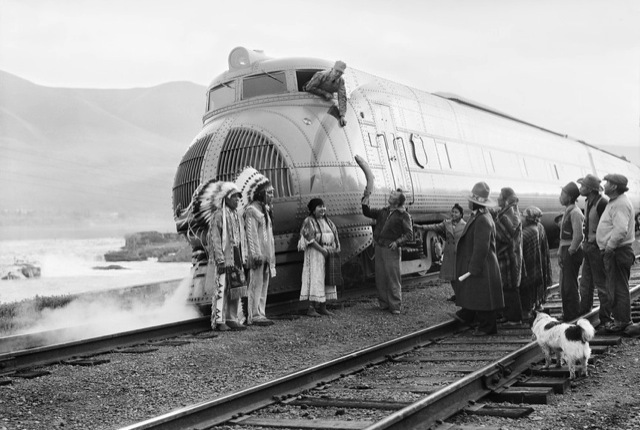
In this curious photo, taken in April, 1940, Indians near Celilo Falls in Oregon’s Columbia River Gorge ceremonially hand a salmon to the fireman of the M-10002 City of Portland.
It then used the M-10002 as the City of Portland. Again, rather than running the M-10001 and M-10002 in every-other-day service, the Union Pacific salvaged the M-10001’s power train for a spare City of Denver and scrapped the rest of the train. The M-10000 was also scrapped in 1942, supposedly to contribute to the war effort.
A new train replaced the M-10002 as the City of Portland by 1941. The M-10002 was then put in service between Portland and Seattle for about a year in 1942 and 1943, then withdrawn and stored before being scrapped in 1947. Despite the huge publicity these trains earned the Union Pacific, their short lifespans are a testament to the failure of their design and technology.
